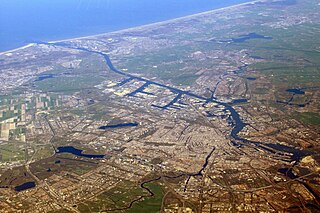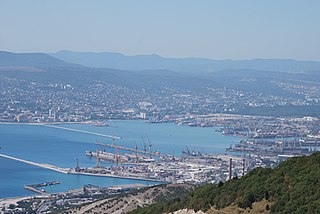This article provides an overview of the transport infrastructure of Latvia.

Panamax and New Panamax are terms for the size limits for ships travelling through the Panama Canal. The limits and requirements are published by the Panama Canal Authority (ACP) in a publication titled "Vessel Requirements". These requirements also describe topics like exceptional dry seasonal limits, propulsion, communications, and detailed ship design.

A cargo ship or freighter is a merchant ship that carries cargo, goods, and materials from one port to another. Thousands of cargo carriers ply the world's seas and oceans each year, handling the bulk of international trade. Cargo ships are usually specially designed for the task, often being equipped with cranes and other mechanisms to load and unload, and come in all sizes. Today, they are almost always built of welded steel, and with some exceptions generally have a life expectancy of 25 to 30 years before being scrapped.

The modern terms short-sea shipping, marine highway, and motorways of the sea, and the more historical terms coastal trade, coastal shipping, coasting trade, and coastwise trade, all encompass the movement of cargo and passengers mainly by sea along a coast, without crossing an ocean.

The Port of Gdańsk is a seaport located on the southern coast of Gdańsk Bay in the city of Gdańsk, extending along the Vistula estuary Martwa Wisła, Port Channel and Kashubia Canal. It is one of the largest seaports on the Baltic Sea.

"Suezmax" is a naval architecture term for the largest ship measurements capable of transiting the Suez Canal in a laden condition, and is almost exclusively used in reference to tankers. The limiting factors are beam, draft, height, and length.
Johor Port is a port in Pasir Gudang, Johor, Malaysia, built in 1977. It is an integrated multi-purpose port facility providing bulk cargo, container and general cargo services. It is the world's largest palm oil terminal and ranks third globally in terms of LME cargo volume.
The Liepaja Special Economic Zone is the only special economic zone in the Baltics consisting of a seaport, industrial area and international airport. Liepāja special economic zone was established in 1997 to develop port operations, cargo handling, logistics, manufacturing and air transportation. The goal of the Liepāja SEZ is to attract investments for the development of the port, manufacturing, and creating new working places.
The Port of Constanța is located in Constanța, Romania, on the western coast of the Black Sea, 179 nautical miles (332 km) from the Bosphorus Strait and 85 nmi (157 km) from the Sulina Branch, through which the Danube river flows into the sea. It covers 3,926 ha, of which 1,313 ha is land and the rest, 2,613 ha is water. The two breakwaters located northwards and southwards shelter the port, creating the safest conditions for port activities. The present length of the north breakwater is 8,344 m (5.185 mi) and the south breakwater is 5,560 m (3.45 mi). The Port of Constanța is the largest on the Black Sea and the 17th largest in Europe.

An oil tanker, also known as a petroleum tanker, is a ship designed for the bulk transport of oil or its products. There are two basic types of oil tankers: crude tankers and product tankers. Crude tankers move large quantities of unrefined crude oil from its point of extraction to refineries. Product tankers, generally much smaller, are designed to move refined products from refineries to points near consuming markets.

The port of Amsterdam is a seaport in Amsterdam in North Holland, Netherlands. It is the 4th busiest port in Europe by metric tonnes of cargo. The port is located on the bank of a former bay named the IJ and the North Sea Canal, with which it is connected to the North Sea. The port was first used in the 13th century and was one of the main ports of the Dutch East India Company in the 17th century. Today, the port of Amsterdam is the second largest port in the Netherlands, the largest being the Port of Rotterdam. In 2014, the port of Amsterdam had a cargo throughput of 97.4 million tons, most of which was bulk cargo.

Riga Free Port is a major port on the east coast of the Baltic Sea, located in Riga, the capital of Latvia. It stretched for 15 kilometers along both banks of the Daugava within the city limits, the area of the port is 1962 ha, water area - 6348 hectares. Navigation is carried out year-round. Most of the cargo turnover is made up of transit cargoes from and to CIS. The main objects of cargo handling are coal, oil products, timber, fertilizer and container cargoes. While the Ventspils Free Port and Liepaja Port specialize in export, a significant part of the activities of the Freeport of Riga is import. At the beginning of the 2000s, the goods arriving at the Riga port amounted to 70 percent of the incoming freight turnover of all the Latvian ports taken together.

Lekki Deep Sea Port, operational, but still partly under construction, is a multi-purpose, deep sea port in the Lagos Free Zone.

Mundra Port is India's first private port and largest container port, located on the northern shores of the Gulf of Kutch near Mundra, Kutch district, Gujarat. Formerly operated by Mundra Port and Special Economic Zone Limited (MPSEZ) owned by Adani Group, it was later expanded into Adani Ports & SEZ Limited (APSEZ) managing several ports. In FY 2020–21, Mundra Port handled 144.4 million tonnes of cargo.

Novorossiysk Sea Port is one of the largest ports in the Black Sea basin and the largest in Krasnodar Krai. At 8.3 km, the NSP berthing line is the longest among all the ports of Russia. The port is located on the Northeast coast of the Black Sea, in the Tsemes Bay. The bay is ice-free and open for navigation all year round. However, in winter the navigation occasionally stops due to the hazardous northeastern bora wind. The Tsemes Bay allows deep-draft vessels up to 19 m DWT, the inner harbour — up to 12.5 m. The liquid bulk terminals depth range from 8.4 to 15.6 m, suitable for tankers with a deadweight of up to 250,000 tons, like Suezmax-class vessels.

Nesskip hf. is an Icelandic shipping company that runs affreightment services based in Reykjavík. The company was established on the 27th of January 1974 in Seltjarnernes and was founded by a group of shipping and bulk transport enthusiasts, led by Captain Gudmundur Asgeirsson who was the first managing director of the company. It is one of Iceland's largest bulk transporting firms. According to Bloomberg it "provides a range of shipping-related services as ship owners, ship brokers, port agents, and transport and chartering consultants", and serves "cruise liners, seismic-research vessels, reefers, tankers, and dry cargo vessels and foreign deep sea fishing ships" as a port agent. The company Nesskip is valued at approximately 240 Million Norwegian Krones (KON); approximately US$23 million. Nesskip purchased its first bulk carrier in February 1974, named the Suðurland and specialises in bulk transport of goods which has been at the fore front of the company's operations for over 40 years. The company deals with the transportation of fishmeal, steel products, construction materials, cement, timber, pumice, coal, gravel, ferrosilicon, and salt as well as other FOSFA cargo. In 1977, Nesskip began to develop a close working relationship with the company Wilson ASA, who specialise in the management of shipping services. It is a member of the international shipping organisation Baltic and International Maritime Council (BIMCO). In 2006, Norwegian shipping company Wilson EuroCarriers acquired a majority share (51.6%) in Nesskip resulting in a change of ownership.
Odessos Shiprepair Yard is situated at the southern end of the city of Varna, Bulgaria, on the island between the old and new canals connecting the Black Sea and the Lake of Varna and is about one mile far from the mouth of Port Varna. Spread over an area of about 320,000 square meters, Odessos is the largest well-equipped yard in Bulgaria suitable for repair and drydocking of vessels up to 35,000 DWT and afloat repairs of vessels up to 150,000 DWT. Odessos Shiprepair Yard is the most busiest yard in the Black Sea.

"Rosterminal" Joint Stock Company (Rosterminalugol) is the largest special-purpose coal port in the Northwest of Russia, built using new technology and providing customers in Europe, African countries, the Middle East and Latin America with Russian coal products from Kuzbass and other coal basins. The automatization level of the port's technological processes is 100%. In 2016, the year-end freight turnover of JSC 'Rosterminalugol' increased by 3.4% and reached an all-time high of 18.1 million tonnes, which represents more than 60% of coal handling in the Baltic basin ports and about 14% among all Russian coal ports.
Taman is a seaport on the Taman Peninsula in area of Cape Zhelezniy Rog, in the village of Volna, near the village of Taman in Temryuksky District of Krasnodar Krai, Russia.
Primorsk Port is the largest Russian oil-loading port in the Baltic Sea and the end point of the Baltic Pipeline System. The port is located on the Björkösund mainland of the Gulf of Finland in the Baltic Sea, 5km south-east from the town of Primorsk.














